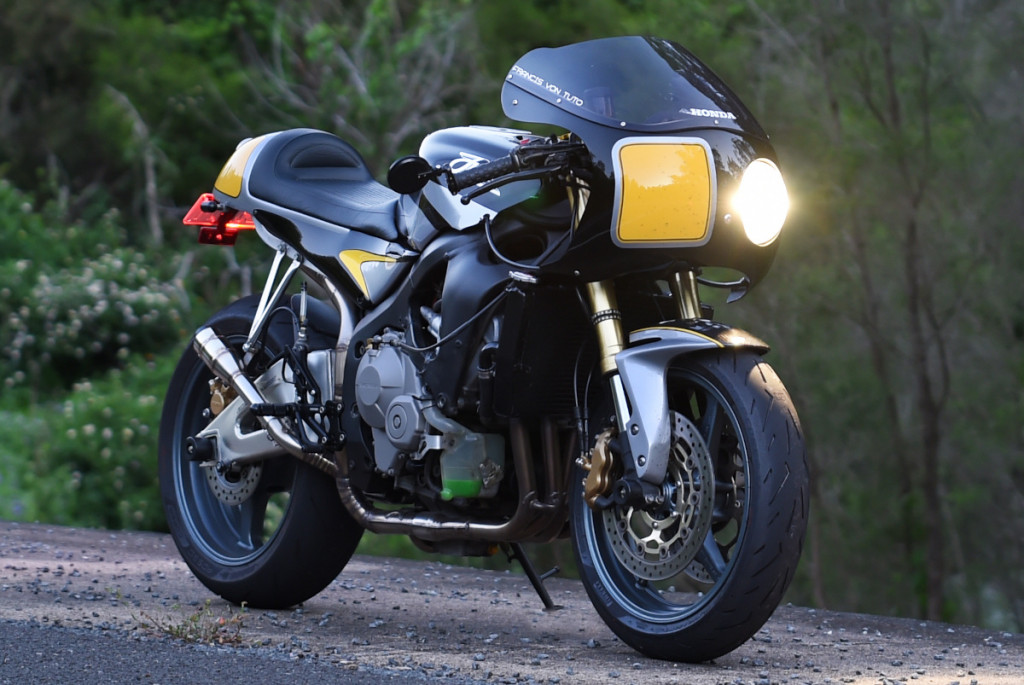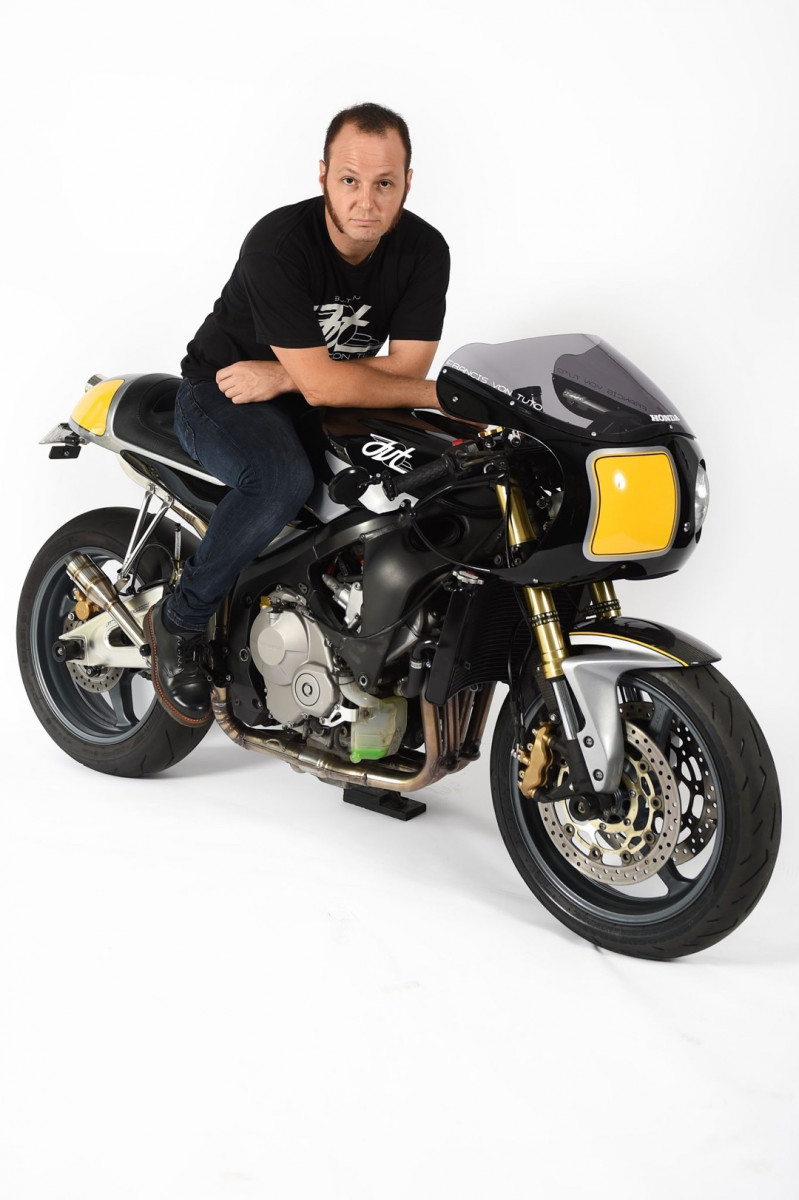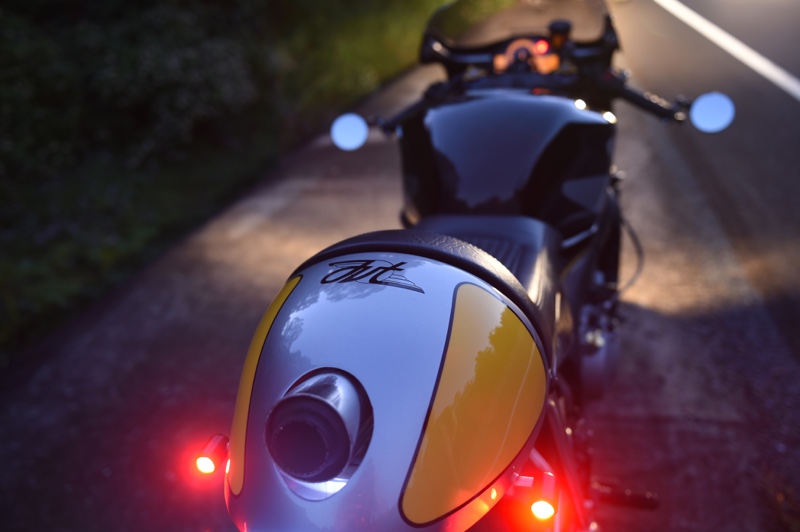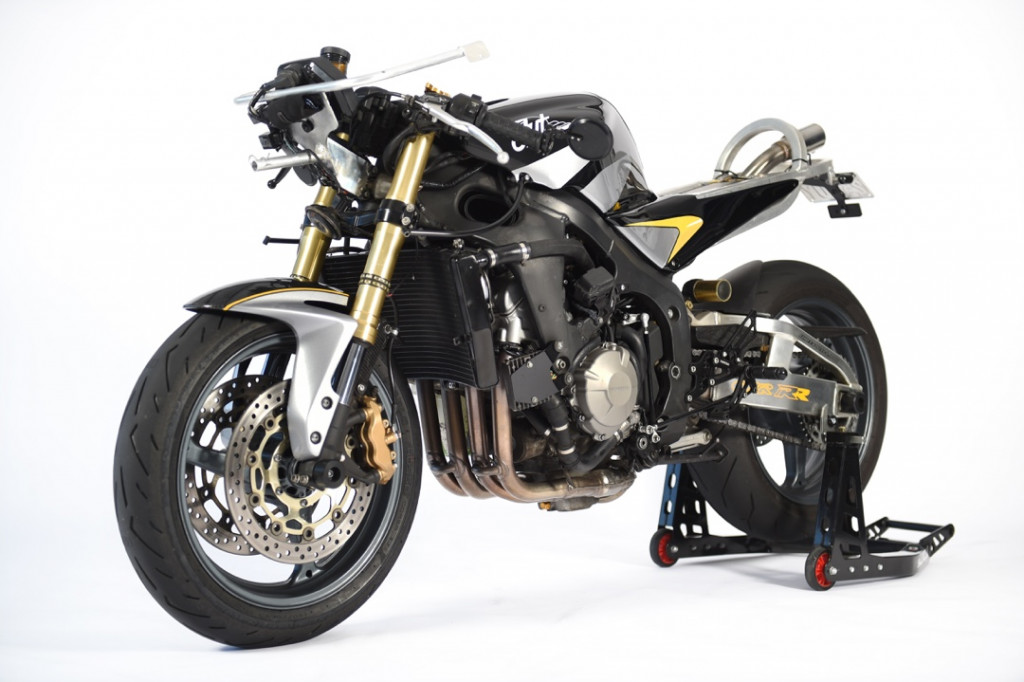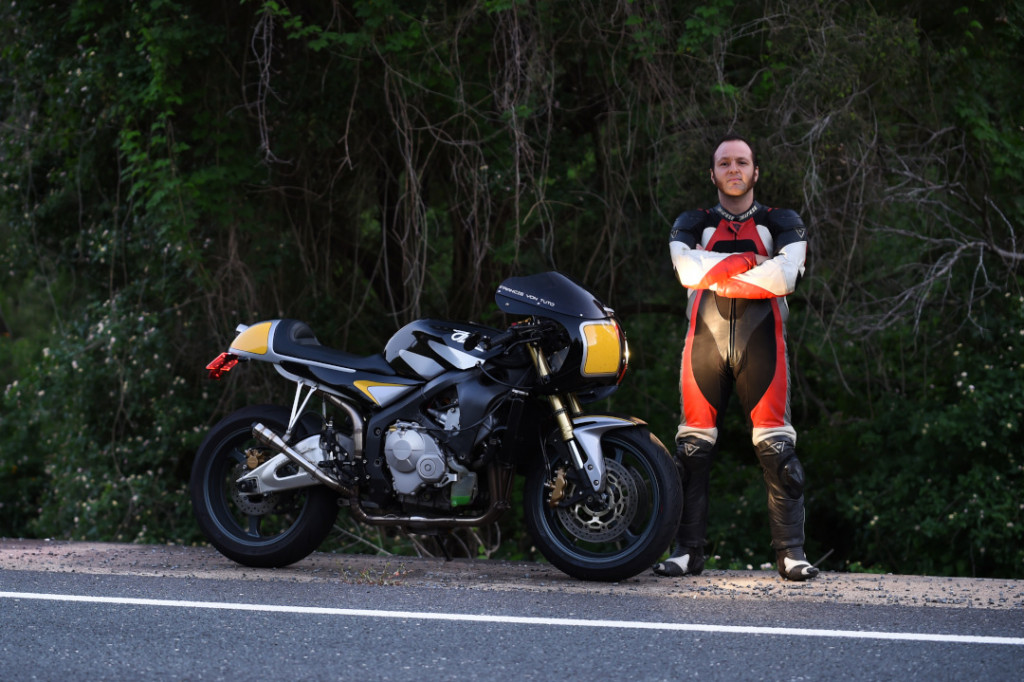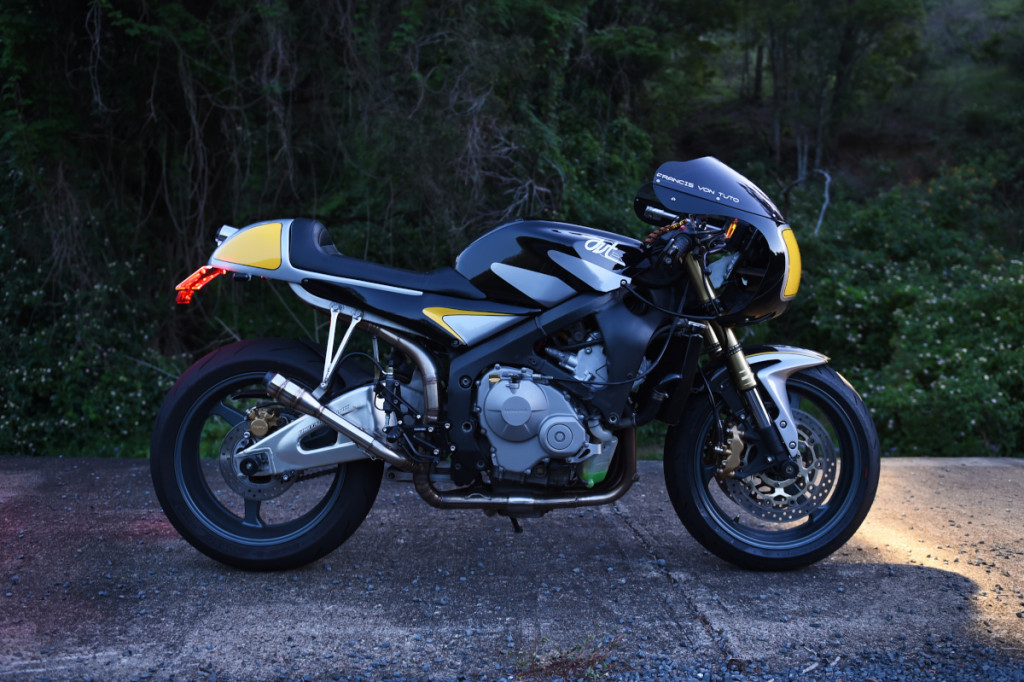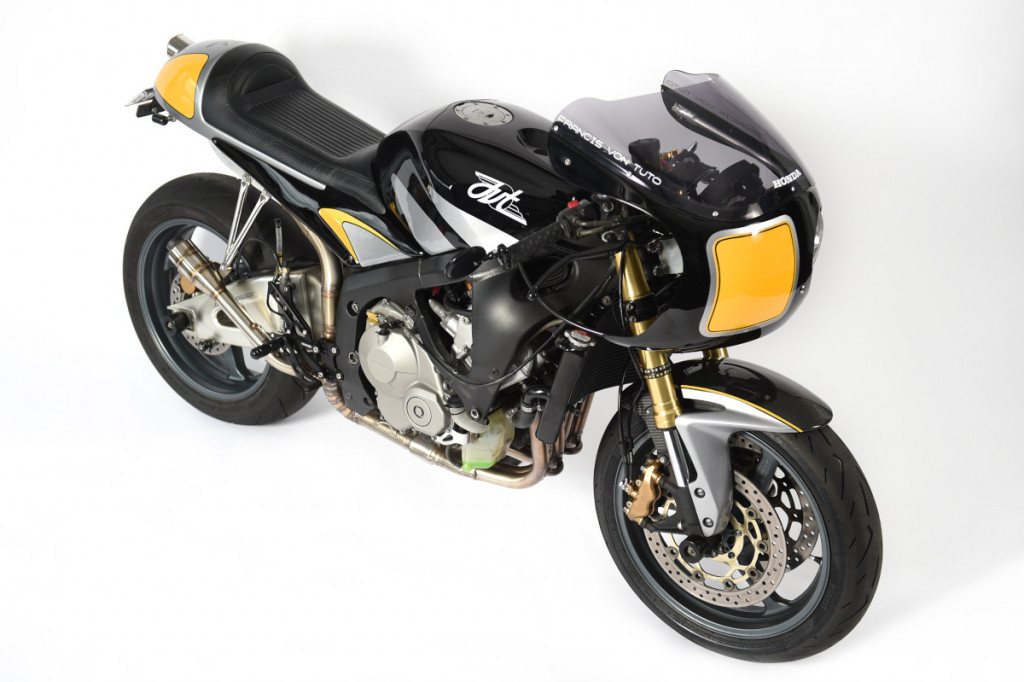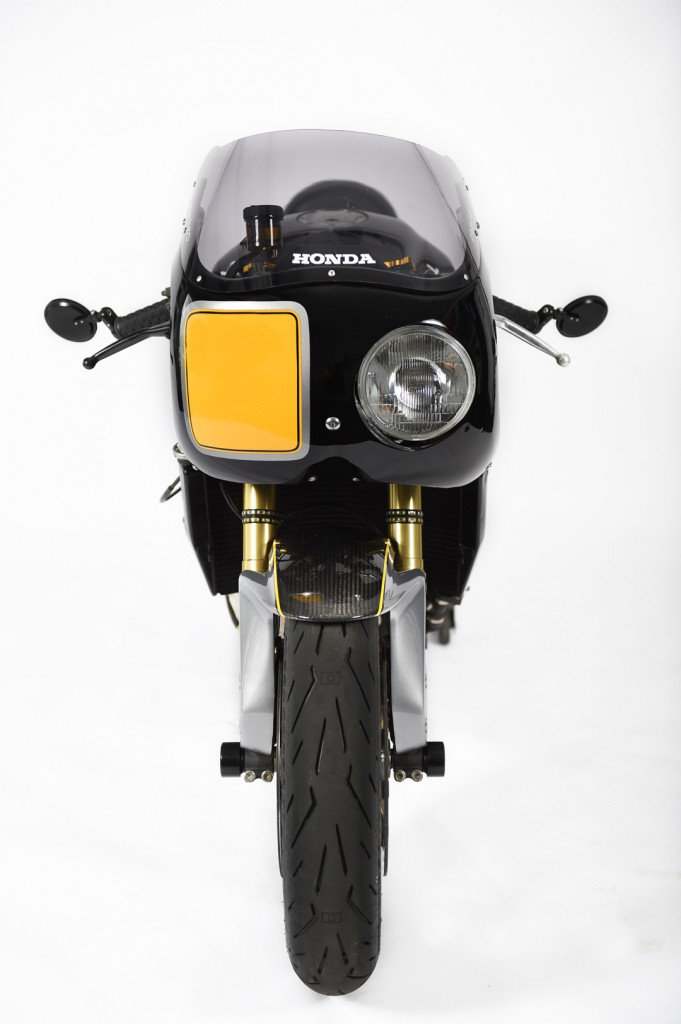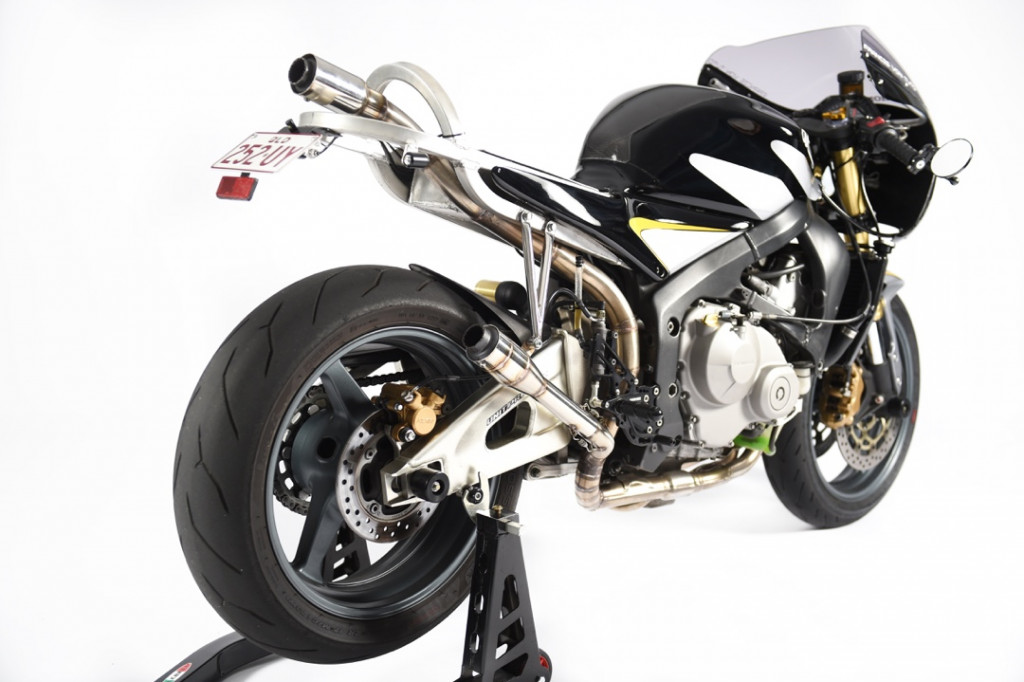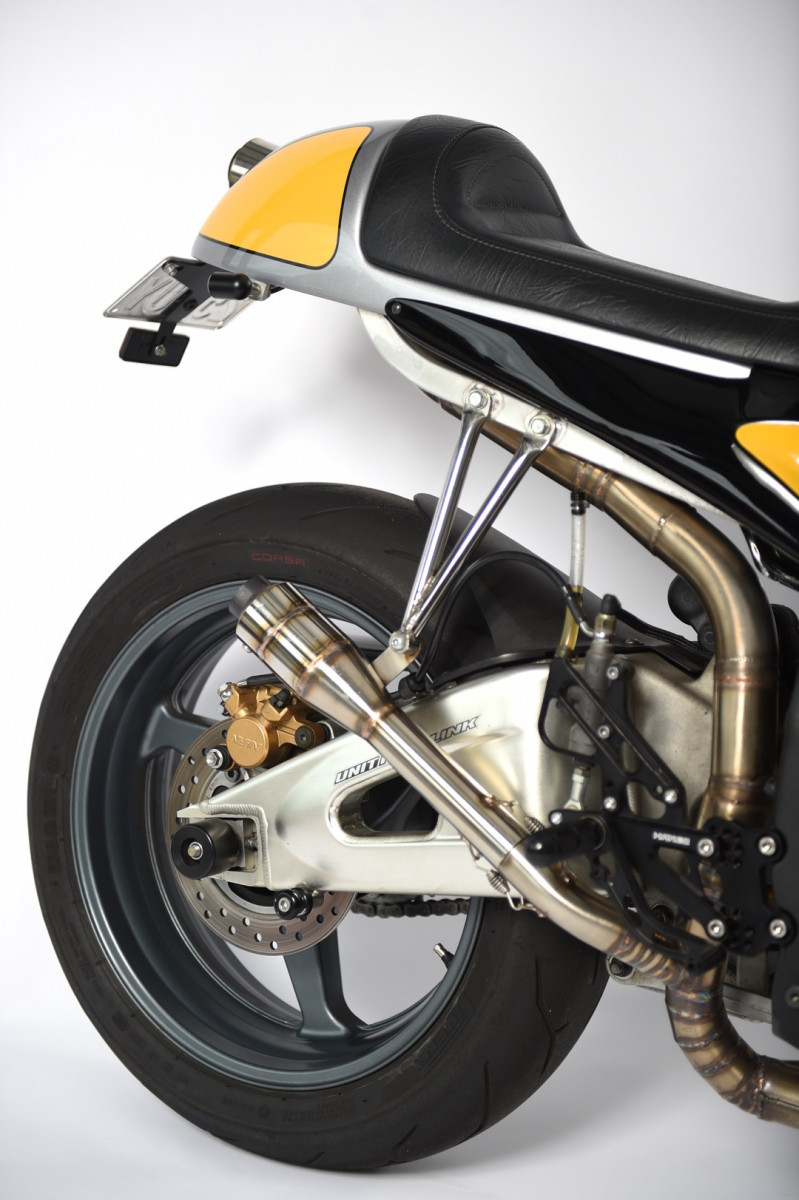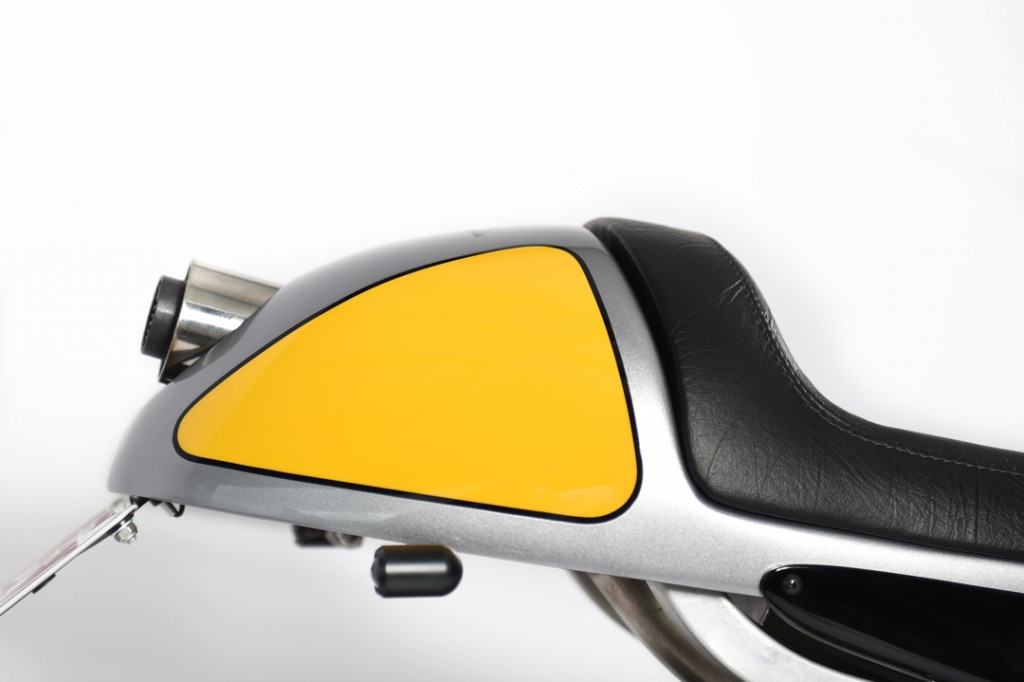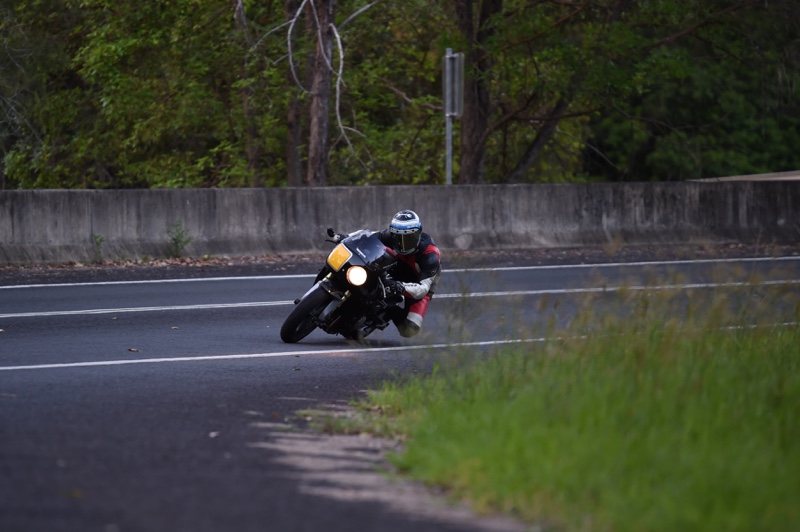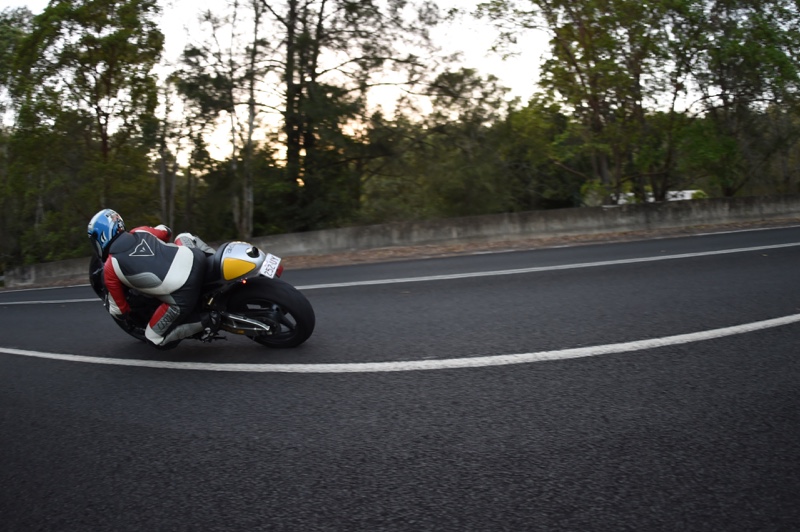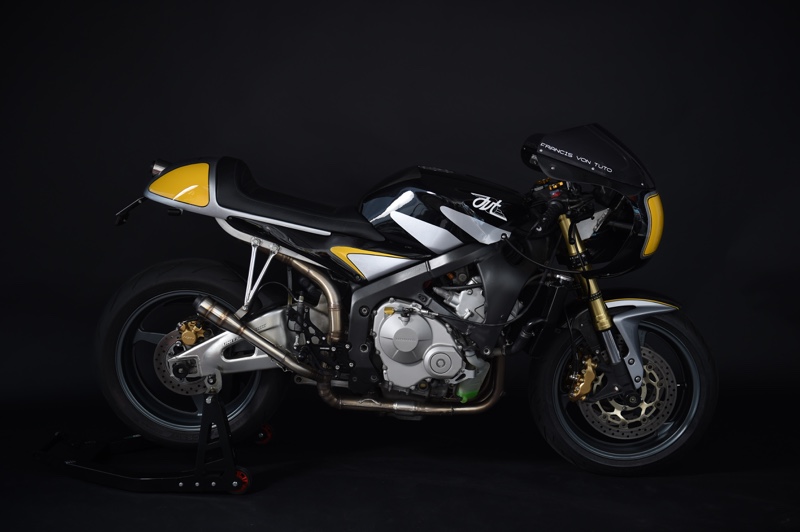The One-Eyed Racer by Francis Von Tuto…
In 2002, Honda launched the original CBR600RR as their top of the line race-replica supersport, boasting a twin-spar aluminum chassis, 115-bhp inline four, and 160 mph top speed. Said GP veteran and 3x British Superbike champion Niall Mackenzie:
“When the original RR was launched…I felt it set new standards in the middleweight class, giving us a one-size fits-all 250cc GP-like bike with the lightweight handling to match and a screaming motor.” –Visordown
Between 2003 and 2015, the CBR600 would reign supreme in the Supersport World Championship, claiming eight championship titles and 10 manufacturer’s crowns. Over the years, it would become even more advanced and uncompromising:
“The Honda CBR600RR is a track biased missile — and an excellent one.” –MCN
Enter our one of our favorite builders, Francesco Tutino of Francis Von Tuto Moto Works. We haven’t heard too much from Francesco in recent months, as he’s been busying moving back to Italy after spending nearly a decade Down Under.
“It has been a hell of a change leaving Australia after 9 years…not necessarily easy but here I am again still building bikes. I’ve now got a new workspace is in the southern part of Florence.”
Francesco is nearing completion of a new build, but one this CBR caught our eye — one of the few FVT creations we’ve never featured. It’s a 2006 CBR600RR nicknamed the “One Eyed Racer” for the Suzuka-style offset headlight.
“As you guys know, this is not my first build, but the previous were all based on classic, vintage motorcycles — not that this ever limited me from making nice handling machines or being the fastest of the group (even on Firestone Champion Deluxe tires!!) — but here I had the chance to play with a 120hp 600cc sportbike, so why not bond my love for classics with my need for a fast ride?”
Francesco says lightness was a must, so he focused on fiberglass and aluminum for the bodywork, brackets, and other fabrication. After doing some major service on the engine and suspension, he stripped off the factory ABS fairings and replaced them with a modified Ducati 900SS race fairing with custom aluminum supports and sa ide-mounted recessed Koito headlight.
Out back is a square-tube aluminum subframe, fiberglass tail, and custom double density foam seat. The fenders and chainguard are carbon fiber, and Francesco hand-built the stainless 4:2 exhaust with inspiration from the Moriwaki system on his CBR600 track bike. Other highlights include LED lightning, adjustable rear sets, Pirelli Rosso Corsa rubber, and more.
We asked Francesco how the bike rides:
“Can’t you tell by the pictures? Haha! Man, it’s a pleasure to ride, it’s fast and with that exhaust note, makes you wanna crack that throttle open! She’s made for the mountain roads!”
And he’s just as proud of how the bike looks naked — especially since he built the bodywork to be removed so easily:
“It looks gorgeous even completely stripped of the bodywork, which is something we wanted to highlight with the photographer. Just think: you can do it within a couple of minutes with just a 4mm allen key!”
Below, Francesco gives us the full story of the build in both English and Italian, with photos courtesy of Dtrain Photography.
Honda CBR600 Café Racer: Builder Interview
• Please tell us a bit about yourself, your history with motorcycles, and your workshop.
Your friend Francis has been back in “the beautiful country” since May 2021. It has been a hell of a change leaving Australia after 9 years…not necessarily easy but here I am again still building bikes. I’ve now got a new workspace is in the southern part of Florence.
• What’s the make, model, and year of the bike?
2006 Honda CBR600RR.
• Why was the bike built?
First of all, I know these machines pretty well — I used to own a Honda workshop when this model first made it to showrooms, and I’ve also owned a few myself. This bike was built when I was still living down down under in sunny Queensland before repatriating to Italy, and it was a personal project.
A few years back, I had the chance to buy this stock standard CBR600 with some cosmetic damage for the right price. The first idea was to convert it to a track bike, but I ended up storing in the garage for a long time until the opportunity for a new custom build came.
• What was the design concept and what influenced the build?
As you guys know, this is not my first build, but the previous were all based on classic, vintage motorcycles — not that this ever limited me from making nice handling machines or being the fastest of the group (even on Firestone Champion Deluxe tires!!) — but here I had the chance to play with a 120hp 600cc sportbike, so why not bond my love for classics with my need for a fast ride.
• What custom work was done to the bike?
I build custom motorcycles so the aim is of course to make aesthetically an “FVT bike,” but it’s still a Japanese sportbike and I want it to keep its good performance…so lightness is a must! Aluminium and fiberglass for structures and bodywork, stainless steel for the exhaust.
After some intensive care and major service to engine and suspension, the complete OEM bodywork was removed along with the front and rear subframes, seats, lights, and exhaust.
For the front I’ve opted for a classic! A Ducati SS fiberglass race top fairing purposely shortened and modified to suit the wider inline 4 chassis and to place a side-mounted recessed Koito projector topped by a tinted windscreen.
The instrument cluster is the original Honda unit, and its aluminum support, which also holds the fairing, has been custom made — with only four screws and an r-clip, you can quickly detach the fairing.
Front fender and chain cover are carbon fiber. The fender is off a later model CBR — looks way leaner and suits the new lines better.
The tank cover is the only plastic bodywork element left on the bike — it needed some tab removal, plastic welding, and bit of shaping to be perfect for its job.
The tail section starts around a fiberglass ducktail, which I honestly don’t remember where I bought it from (probably found at the umpteenth swap meet). I did build a dedicated square-tube aluminum subframe for it with the help of my good friend and top welder Craig.
It also holds a generous aluminum battery tray, and where the last bends of one of the exhausts travel before coming out in the middle of the tail hump.
It’s topped by a finely upholstered double density foam custom seat of my own design, bonded to the tank with fiberglass side fairings I’ve made reshaping the standard plastic ones then creating moulds and many hours later, popping out these two one-off pieces.
Lights at the back are full LED; indicators are the 3-in-1 types so the tail is clean from any brake light. There is only a small LED tucked under the fiberglass illuminating the number plate. At the front a very simple and clean solution was found by using adhesive LED strips around the forks.
The exhaust, which is an interesting feature of this bike, was inspired by the Moriwaki full system I had on my previous CBR — beautiful but not supposed to work efficiently for road use below 8000 rpm. Throttle response was pretty dull (indeed it’s now fitted under my current track bike, a first series CBR600RR).
It’s full stainless and completely hand built. It uses the original headers with a modified manifold to make it a 4-into-2 replica, with the larger diameter main pipe running under the seat and the smaller and shorter one off the side. The two mufflers are made from straight tubes and concentric reducers, packed with little “bomb baffles.” I am no engineer and didn’t properly study pipework technics, but with the stock engine and a hi flo air filter, this exhaust works a treat!
To complete the job a pair of brand new Pirelli Rosso Corsa, sintered pads, and Brembo radial master cylinder with braided lines were fitted. Adjustable rearsets were the cherry on top!
For the livery I’ve chosen gloss black and very fine metallic grey with yellow elements. I didn’t want to make it look like a replica but I’ve opted for a simple combination of colours that would still recall the bike’s racer personality.
• Does the bike have a nickname?
Yes, it’s called “One Eyed Racer.”
• Can you tell us what it’s like to ride?
Can’t you tell by the pictures? Haha! Man, it’s a pleasure to ride, it’s fast and with that exhaust note, makes you wanna crack that throttle open! She’s made for the mountain roads!
• Was there anything done during this build that you are particularly proud of?
The exhaust system is something I’ve really enjoyed building, but what I like the most from this bike is the fact that it looks gorgeous even completely stripped of the bodywork, which is something we wanted to highlight with the photographer. Just think: you can do it within a couple of minutes with just a 4mm allen key!
Follow the Builder
Web: www.francisvontuto.com
Facebook: Francis Von Tuto
Instagram: @francis_von_tuto
Photo credit: Dtrain Photography
Fiberglass supply: Paul Borowinsky
Builder Interview: In Italiano
• Please tell us a bit about yourself, your history with motorcycles, and your workshop.
Mi chiamo Francesco Tutino, classe 1984, appassionato di due ruote da sempre, nel mondo delle moto dal 2000 anno in cui cominciai i primi passi come meccanico moto, per poi diventare una carriera di oltre 20 anni. Di questi anni 9 li ho passati in Australia, dove ho cominciato a costruire special come Francis Von Tuto fino al quando sono tornato nel “Bel Paese” a maggio 2021, è stato un bel cambiamento… non proprio facile ma quello che conta è che sono ancora qui a costruire moto nel mio nuovo spazio nel Valdarno a poche curve da Firenze.
• What’s the make, model, and year of the bike?
2006 Honda CBR600RR.
• Why was this bike built?
Prima di tutto conosco piuttosto bene questo modello, avevo un’officina Honda nel periodo in cui questo modello fece il suo debutto nelle concessionarie, oltre ad averne possedute diverse…
Questa moto l’ho costruita quando ancora vivevo nel soleggiato Queensland prima di rimpatriare in Italia ed era un progetto personale. Comprata qualche anno prima ad un prezzo ragionevole tutta originale ma con qualche difetto estetico, l’idea era quella di farci una moto da pista ma fu presto messa da parte per poi ritirarla fuori quando decisi di customizzarla
• What was the design concept and what influenced the build?
Come sapete amici di Bikebound, questa non è la mia prima special ma tutte le altre che avevo costruito prima erano su basi d epoca, non che questo mi abbia mai limitato nel costruire moto con cui potersi veramente divertire (anche con le Firestone Champion Deluxe!!) ma qui avevo la possibilità di mettermi a lavorare su di una 600 supersportiva da 120cv, quindi potevo unire la mia esigenza di performance e guidabilità ad uno stile che sta più nelle mie corde, che figata!
• What custom work was done to the bike?
Costruendo motociclette customizzate tento sempre di dare ai mezzi su cui lavoro un tocco del mio stile tenendo sempre di conto le guidabilità e performance. In questo caso poi data la base di partenza direi che era d obbligo, quindi un aspetto fondamentale era di giocare sulla leggerezza.
Alluminio e fibra di vetro per strutture e carrozzeria, acciaio inox per lo scarico. Dopo un bel tagliando completo dalla A alla Z ho rimosso tutto quello che c era di plastica sulla moto, carenatura, fanali, selle e insieme anche scarico e telaietti.

Per l anteriore sono andato sul classico… cupolino da corsa Ducati SS900 debitamente accorciato e modificato per montare sul ben più ampio telaio del 4 cilindri in linea e rimodellato per alloggiare un faretto alogeno della Koito incassato sul lato sinistro, ed un plexiglas fumè.
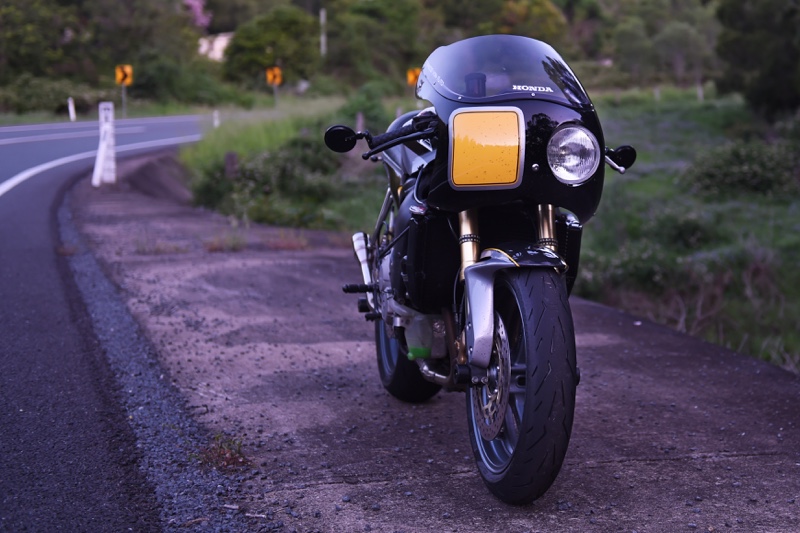
La strumentazione è quella originale, montata su di un supporto artigianale in alluminio che fa anche da sostegno a sgancio rapido per il cupolino, rimovibile con sole 4 viti ed una coppiglia.
Il parafango anteriore come anche il para catena sono di fibra di carbonio ma di un modello di cbr più recente, dalle forme più snelle e azzeccate per questo progetto.

La copertura del serbatoio è l unico elemento rimasto in plastica, con qualche accorgimento di termo saldatura e rimodellamento sono riuscito ad adattarlo alla nuova linea.

Spostandoci sulla sezione posteriore abbiamo un codino monoposto in fibra di vetro, di cui ignoro la provenienza (probabilmente recuperato alla ennesima mostra scambio) per il quale grazie al preziosissimo aiuto del mio amico e saldatore Craig è stato costruito un telaietto ad hoc in tubi d alluminio a sezione quadra, dove alloggia un generoso portabatteria/portaattrezzi e passano le ultime curve dello scarico che fuoriesce dal codino.
La sella ha una base in fibra di vetro e gommapiuma a doppia densità rivestita in sky nero con cuciture grigie, completamente artigianale come le fiancatine laterali, sempre in fibra ricavate da un modello in creta basato sulle originali e rimodellate per congiungersi al codino.
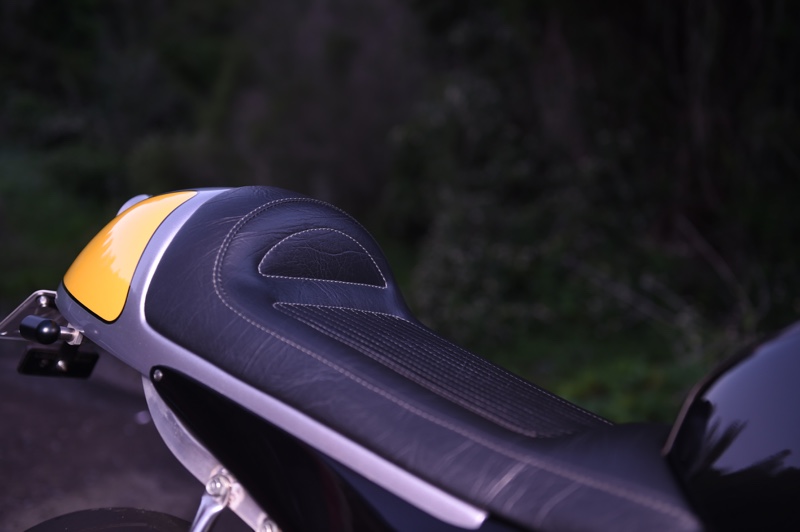
L illuminazione al posteriore è full LED con frecce e stop 3 in 1 così da lasciare la coda libera dalle luci di stop, c’è solo un piccolo led sotto la scocca di resina ad illuminare la targa, mentre per le frecce anteriori sono state utilizzate delle strisce LED intorno ai foderi forcella.
Lo scarico è una delle caratteristiche che preferisco di questo progetto, è interamente in acciaio inox ispirato ad un impianto completo da corsa moriwaki 4 in 2 che utilizzavo sul mio cbr precedente, era bellissimo ma non proprio adatto per uso stradale visto che cambiava completamente la curva di erogazione rendendo la moto praticamente morta sotto gli 8000 giri (Non a caso ora è montato sul mio attuale CBR600RR da corsa).

Per la realizzazione ho modificato i collettori originali eliminando il catalizzatore e costruendo un raccordo a doppia uscita con diametri diversi, una più corta e stretta laterale ed una più larga e lunga che finisce sotto la coda, i terminali sono ricavati da tubo di 60mm e silenziati da mini cartucce fonoassorbenti che avevo su uno scaffale in officina. Sono molto contento del risultato perché nonostante il look e il sound spettacolare funziona anche molto bene con il motore stock.
Il lavoro viene completato montando le ultime migliorie da catalogo: coperture Pirelli Rosso Corsa 2, pompa radiale brembo, tubazioni dei freni aereonautiche e pedane arretrate.

In fine la livrea doveva essere semplice, corsaiola ma assolutamente non una replica. Nero e grigio metallizzato con porta numeri ed elementi gialli, Classica ma efficace.
• Does the bike have a nickname?
Si, essendo una supersportiva con quel suo faro laterale in stile 8 ore di suzuka e il portanumero accanto a mo di “benda sull occhio” si è meritata il nome “One Eyed Racer.”
• Was there anything done during this build that you are particularly proud of?
Vado particolarmente fiero dello scarico, ma quello che mi piace di più di questa moto è il fatto che sembra bellissima anche completamente spogliata della carrozzeria ed è qualcosa che volevamo evidenziare con il fotografo, pensa che puoi rimuovere il tutto in un paio di minuti con una chiave a brugola da 4 millimetri!
Segui il Costruttore
Web: www.francisvontuto.com
Facebook: Francis Von Tuto
Instagram: @francis_von_tuto
Photo credit: Dtrain Photography
Fiberglass supply: Paul Borowinsky
More FVT Builds
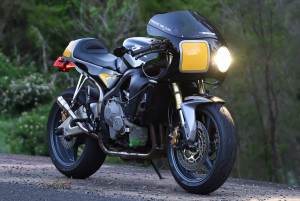 Made for Mountain Roads: Honda CBR600RR Café Racer - The One-Eyed Racer by Francis Von Tuto… In 2002, Honda launched the original CBR600RR as their top of the line race-replica supersport, boasting a twin-spar aluminum chassis, 115-bhp inline four, and 160 mph top speed. […]
Made for Mountain Roads: Honda CBR600RR Café Racer - The One-Eyed Racer by Francis Von Tuto… In 2002, Honda launched the original CBR600RR as their top of the line race-replica supersport, boasting a twin-spar aluminum chassis, 115-bhp inline four, and 160 mph top speed. […]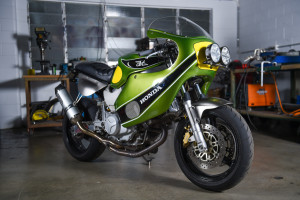 Farewell VTR: Honda VTR1000 by Francis Von Tuto - For Sale: 1000cc V-Twin “FTVR” from Francis Von Tuto… In the 1990s, Carl Fogarty had been putting the hammer down on the Japanese fours in World Superbike, piloting his booming Ducati to four championships. Riders […]
Farewell VTR: Honda VTR1000 by Francis Von Tuto - For Sale: 1000cc V-Twin “FTVR” from Francis Von Tuto… In the 1990s, Carl Fogarty had been putting the hammer down on the Japanese fours in World Superbike, piloting his booming Ducati to four championships. Riders […] Parts Bin Special: “Green & Gold” Yamaha SR400 - For Sale! A #coronavirusbikebuildoff Yamaha from Francis Von Tuto… The Yamaha SR400 is one of the world’s best-loved singles, an air-cooled Universal Japanese Motorcycle that’s been in production for some four decades. The engine is […]
Parts Bin Special: “Green & Gold” Yamaha SR400 - For Sale! A #coronavirusbikebuildoff Yamaha from Francis Von Tuto… The Yamaha SR400 is one of the world’s best-loved singles, an air-cooled Universal Japanese Motorcycle that’s been in production for some four decades. The engine is […]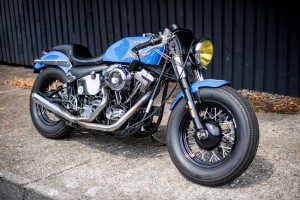 Big Twin Cafe Racer: “The Flying Duck” - Sometimes a motorcycle becomes so deeply involved and entangled with our personal history that it becomes a part of our life story — an integral part of who we are. Such is the case with […]
Big Twin Cafe Racer: “The Flying Duck” - Sometimes a motorcycle becomes so deeply involved and entangled with our personal history that it becomes a part of our life story — an integral part of who we are. Such is the case with […]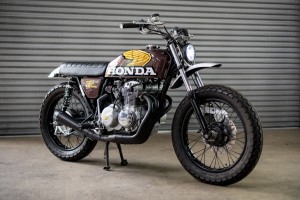 Urban Scrambler: Honda CB400F by Francis Von Tuto - A lightweight curb-jumper from Down Under… The Honda CB400F Super Sport — aka Honda 400 Four — has been called Japan’s first real sportbike. In an era when many riders were more interested in straight-line […]
Urban Scrambler: Honda CB400F by Francis Von Tuto - A lightweight curb-jumper from Down Under… The Honda CB400F Super Sport — aka Honda 400 Four — has been called Japan’s first real sportbike. In an era when many riders were more interested in straight-line […]
